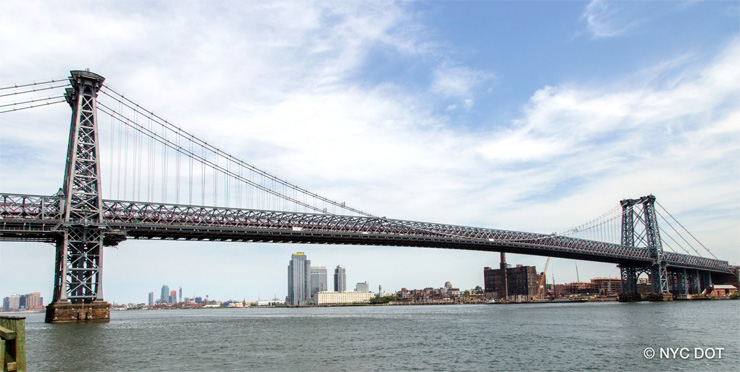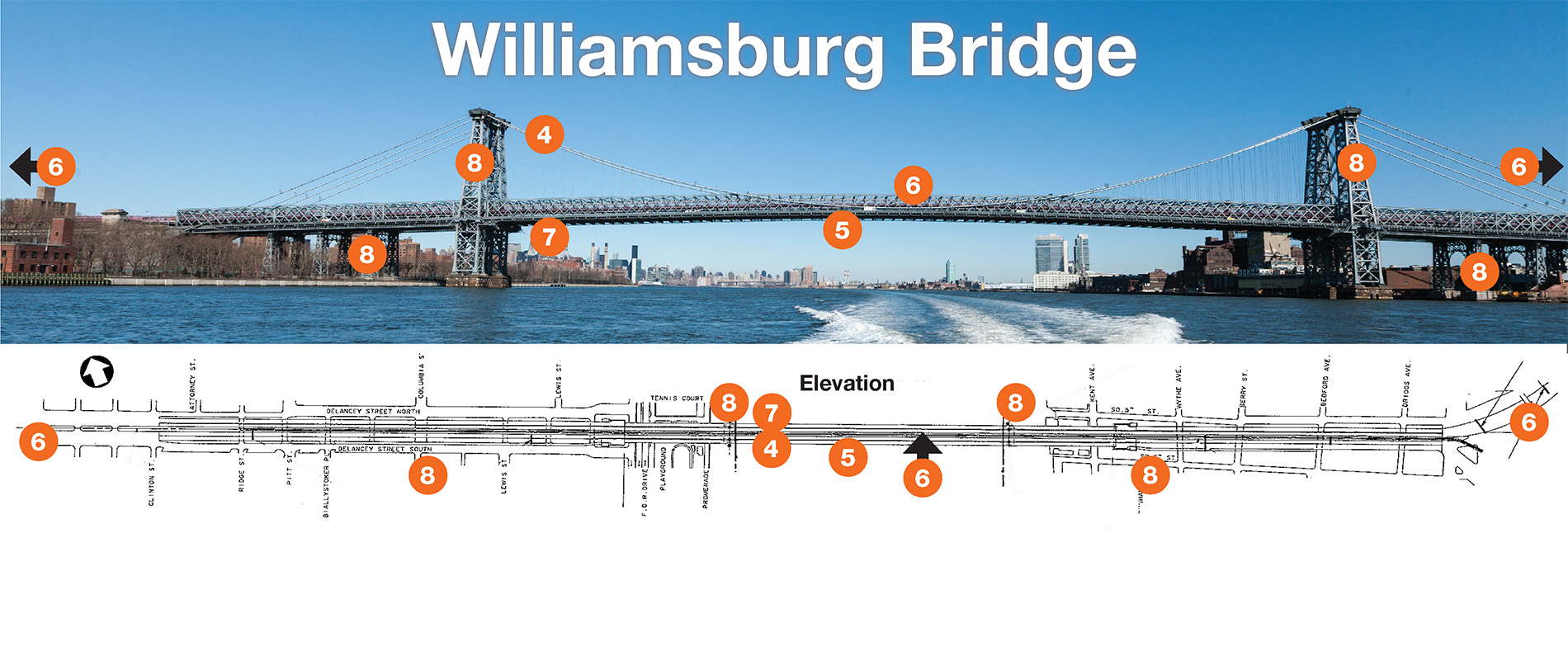Williamsburg Bridge
About the Bridge
The Williamsburg Bridge is one of the major crossings of the East River, connecting Manhattan and Brooklyn and serving some of the busiest arteries in New York City. As of 2018, an average of over 104,700 vehicles, 6,700 cyclists and 5,500 pedestrians travel over the Williamsburg Bridge each day.

Bridge Facts
- Total length: 7,308 feet
- Main span: 1,600 feet
- Clearance at center: 135 feet
- Height of towers: 310 feet
- Number of cables: 4 cables
- Diameter of each cable: 18 inches
- Weight of cables: 4,344 tons
- Total length of wires: 17,500 miles
History
When it opened in 1903, the Williamsburg Bridge was the longest suspension bridge in the world, carrying rail, trolley, carriages and pedestrians. The Williamsburg Bridge was one of the last major bridges designed for the horse and carriage. By the 1920s, when the automobile became a major mode of transportation, the trolley tracks were replaced with roadways.
The massive stiffening trusses were designed not only to withstand high winds, but also to support rail traffic on the deck. Currently, the bridge carries four two-lane vehicular roadways, a south roadway (inner and outer) and north roadway (inner and outer), with two rapid transit tracks (J, M, and Z subway lines) sandwiched in between. A walkway and a bikeway also run across the bridge.
Current Project
Reconstruction of Williamsburg Bridge and Miscellaneous Rehabilitation
The Williamsburg Bridge rehabilitation program continues under Contract No. 9. The project focuses on structural steel repairs and other miscellaneous rehabilitation. The anticipated completion is Spring 2026.
Project Scope:
- Structural repairs
- Seismic retrofit of the main bridge (side spans)
- Rehabilitation of intermediate towers
- Partial pavement repairs and anchorage joint replacement
Impacts
- Single-lane closures in the Manhattan-bound inner and outer lanes
- Single-lane closures in the Brooklyn-bound inner and outer lanes
- Bikeway and walkway are narrowed at the work zones
Construction Project Contact:
For more information about this project, please contact Anita Navalurkar, the community liaison for the Williamsburg Bridge Rehabilitation/Contract No. 9, at WBB9Rehab@gmail.com or 347-647-0876.
Previous Contracts


4Contract 4 (1991-1994): Cable rehabilitation, including oiling and wrapping of main cables and replacement of all suspenders, $90M
5Contract 5 (1994-1997): Reconstruction of the South Roadways, including a new orthotropic bridge deck and footwalk on the south side of the main bridge, $295M
6Contract 6 (1997-2000): Complete replacement of the transit approaches, and rehabilitation of the transit structure on the main bridge, $175M
7Contract 7 (1999-2002): Reconstruction of the North Roadways, including a new orthotropic bridge deck and footwalk on the north side of the main, $250M
8Contract 8 (2003-2012): Bridge Tower Rehabilitation, Replace main tower saddle stops, Install seismic shear keys at intermediate towers, Tower access improvements, Replace fenders/mooring facilities, Integrate and complete ITS, Replace approach sign gantries and Bridge Tower Painting, $290M
